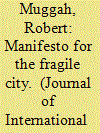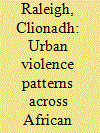|
|
|
Sort Order |
|
|
|
Items / Page
|
|
|
|
|
|
|
| Srl | Item |
| 1 |
ID:
138408


|
|
|
|
|
| Summary/Abstract |
After more than a century of steady city expansion in northern countries, the direction of twenty-first century population growth is shifting southwards. Over the next five decades, Africans, Arabs, and Asians will migrate in unprecedented numbers to cities, especially to their slums. Many of these urban settlements are insecure, disorganized, and violent. These are fragile cities and such migrations can threaten their inhabitants, countries, and the wider neighborhood. The analytical focus on fragile cities offers a novel scale when compared to fragile and failing states. It is also one that is preoccupying national policymakers, military strategists, and development experts. Drawing on theoretical and empirical contributions from geography, criminology, and sociology, this article identifies four mega-risks shaping urban fragility—the transformation and concentration of violence, turbo-urbanization, youth bulges, and the relentless penetration of new technologies. It also considers successful approaches to reversing city fragility, including twinning fragile cities with healthier and wealthier ones, investing in hotspot policing, interventions addressing at-risk youth, support for inclusive and cohesive urban growth, and the targeted application of new technologies.
|
|
|
|
|
|
|
|
|
|
|
|
|
|
|
|
| 2 |
ID:
137789


|
|
|
|
|
| Summary/Abstract |
This analysis of urban political violence across Africa considers why the proportion and frequency of conflict is increasing in urban areas while decreasing in rural areas. The decline of formally organized violence in predominantly rural areas, and the increase of more variegated forms of political opposition and conflict in urban zones, is interrogated through demographic and grievance-based explanations. Urban violence displays a range of agents, goals, intensities, and triggers and is alternatively regarded as a response to the lack of capacity and poor governance found in urban contexts, or to the changing demographic and political character of African states. Yet, the multiple, low-intensity forms of urban violence present—including militia attacks, communal contests, riots, and protests—indicate a change in the collective action capabilities and goals of modern conflict agents. These goals are themselves shaped by the experience of mounting urban grievances, but the ethnic and regional heterogeneity in urban areas prevents substantial collective action to counter the urban marginalization practiced by many African governments. Despite the low-intensity nature of urban threats, this compounded violence is a substantial security threat across developing states and is leading to the rise of the “fragile city.”
|
|
|
|
|
|
|
|
|
|
|
|
|
|
|
|
|
|
|
|
|